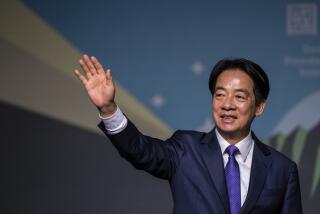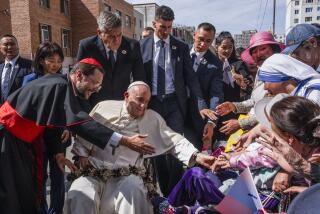Is a Geography Lesson in Order?
TAIPEI, Taiwan — This little island yearns for international recognition.
It’s desperate for membership in world bodies such as the United Nations. Its people want to be seen as players in their own right, not just as a rich appendage of the Chinese mainland. Its government coddles the few diplomatic allies it has left, mostly impoverished countries that receive hefty financial aid in return for not moving their embassies to Beijing.
But in an ironic quirk of history and politics, what Taiwan craves from the world it withholds from one of its regional neighbors.
To this day, the Taiwanese government refuses to recognize Mongolia as an independent country, considering it instead a part of China.
It’s a somewhat embarrassing situation for a place that is itself trying to shake off China’s long shadow--and the scenario isn’t set to change any time soon.
The anomaly has its roots in Chinese history. After Chiang Kai-shek fled to Taiwan from the Communist-won mainland in 1949, he and his Nationalist Party continued to proclaim themselves the legitimate government of all China. For him, that included Mongolia, which was largely under Chinese control until 1921.
Forget that even Mao Tse-tung--no shrinking violet over Chinese unification--recognized Mongolia as a separate state Oct. 16, 1949. Or that Mongolia was a Soviet satellite for most of the 20th century and became a self-governing democracy starting in 1990.
According to Taiwan’s constitution, Mongolia doesn’t exist--except as a piece of Chinese territory. Why? Some fear that by recognizing Mongolia, Taiwan would be a short step away from completely abandoning its historic claim to be the rightful government of China.
“People recognize that it’s a fiction,” Frederic Chang, deputy chief of Taiwan’s Government Information Office, acknowledged a little sheepishly. After all, “it’s independent, it has its own government and it’s a member of the U.N.,” he said. “But it’s a complicated issue--and one charged with emotion. . . . We’re going to have to address this.”
A few Taiwanese legislators tried to do so in 1996, arguing that it was time to surrender to the obvious and recognize Mongolia’s sovereignty, as most every other nation had done. But the proposal met with heated debate and was ultimately shelved for lack of consensus.
It may seem like much ado about not a whole lot. Mongolia, though nearly 50 times the size of Taiwan, has only one-tenth of Taiwan’s population. It’s still a nation of poor nomadic herders.
Mongolia’s economy is less than 2% the size of Taiwan’s.
In 1995, a Taiwanese newspaper poll found that more than a third of residents considered Mongolia part of China. Nearly a quarter said they had never even heard of the Mongolian People’s Republic, the country’s formal title.
“If you hadn’t told me, I’d still have thought Mongolia was part of China today,” Michael Liu, a thirtysomething restaurateur in Taipei, the capital, admitted recently.
The tortured relationship between Mongolia and China stretches back hundreds of years. In the 13th century, the Mongols under Kublai Khan conquered China and founded the Yuan Dynasty. It was the Mongols who first made Beijing, which they called Tatu, the capital of China.
The Yuan Dynasty lasted 97 years, after which the Mongols withdrew. In the 18th century, China turned the tables and overran Mongolia, ruling it until the Qing Dynasty--China’s last--crumbled in 1911. Although Mongolia declared independence that year, China paid it no heed; Chinese troops weren’t ejected from Mongolia until 1921.
Except for a brief period, Chiang’s Nationalists have always considered Mongolia part of China. World maps sold in Taiwan still show Mongolia within Chinese borders. Taiwan’s Mainland Affairs Council made a grudging concession three years ago by allowing Mongolia to be shaded differently from the Chinese province of Inner Mongolia, turning it almost literally into a gray area. The council declared that the change would “clear up confusion.”
Some believed that last year’s change in the Taiwanese leadership might trigger a reevaluation of Mongolia’s status, because the new president, Chen Shui-bian, belongs to a political party that advocates Taiwanese independence and disentanglement from mainland China altogether.
When he was mayor of Taipei, Chen made a trip to Mongolia, after which the Assn. for Taiwanese-Mongolian Affairs was set up to promote contacts. One of his policy advisors, Lee Fang-kang, visited Mongolia last year within months of Chen’s inauguration as president.
But no changes in the political horizon are imminent, said a staff member of the government’s Cabinet-level Mongolian and Tibetan Affairs Commission.
In truth, Taipei has little to gain diplomatically from recognizing Mongolia as a sovereign state. Such a move would not result in the establishment of full diplomatic ties or an exchange of embassies, for example.
Mongolia acknowledges the Communist regime in Beijing as the rightful government of China, and when Chinese President Jiang Zemin made a state visit to Ulan Bator, the capital, two years ago, Mongolian President Natsagiin Bagabandi firmly stated his commitment to Beijing’s cherished “one China” principle, which holds that Taiwan belongs to China.
“Taiwan is an inalienable part of Chinese territory,” Bagabandi declared--exactly what Taiwan says about Mongolia.
The biggest payoff that a recognition of an independent Mongolia would bring Taiwan would be economic. The two sides could then open trade and cultural exchange offices in Taipei and Ulan Bator as unofficial embassies. Some Taiwanese state and private enterprises have begun eyeing Mongolia as a place to invest. At present, trade between the two sides amounts to just a few million dollars.
So change may yet come, though no one knows when.
“You have to be realistic,” said Chang of the Government Information Office, whose official seal bears a map of China--Mongolia included.
More to Read
Sign up for Essential California
The most important California stories and recommendations in your inbox every morning.
You may occasionally receive promotional content from the Los Angeles Times.











